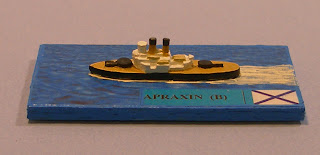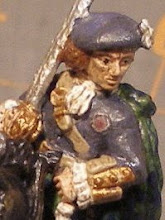Just this past Friday evening I completed the last of the Russian Baltic Fleet (4 battleships and 5 cruisers). They are presented for your viewing enjoyment. All models are 1:2400 scale ships from
Panzerschiffe Miniatures. Please click on the photos for a larger image.
The Baltic Fleet was divided into two sea-going squadrons and sent on an immensely long voyage to the Far East, there to meet their doom against the Japanese fleet at Tsu-shima in the Korean Straits. A few of the ships survived the battle, some were captured and incorporated into the Japanese fleet, and some were sunk.
The four modern battleships of the 1st Battle Division, 2nd Pacific Squadron were already posted immediately preceding this post.
The 2nd Battle Division, 2nd Pacific Squadron consisted of three battleships and one armored cruiser. The three battleships' pictures have already been posted previously. The only new ship here is:
Admiral Nakhimov, armored cruiser.
3rd Battle Squadron, 3rd Pacific Squadron, consisting of:
battleship Nikolai I (division flag), one of the first Russian battleships and hopelessly obsolescent;
battleship Admiral Ushakov, also obsolescent;
battleship Admiral Senyavin, of the Ushakov class; and
battleship General-Admiral Graf Apraxin, also of the Ushakov class.
Cruiser Division, consisting of four of the cruisers (two of which, Aurora and Dmitri Donskoi, have been pictured already):
protected cruiser Oleg (division flag) and
armored cruiser Vladimir Monomakh (near sister of Donskoi), obsolescent.
There were also two modern "light" cruisers of the same class that were attached for scouting:
protected cruiser Izumrud (meaning Emerald) and
protected cruiser Jemchug (meaning Pearl).
With the exception of one yacht-cruiser (Svietlana), three destroyers, and the fleet auxiliaries that accompanied the Baltic Fleet, that completes all my Russian ships for the Russo-Japanese War. As Panzerschiffe makes a Svietlana, I may end up getting it although it didn't take part in the Battle of Tsu-shima, having been ordered to escape to Vladivostok at the start to let them know the fleet was coming. I'm also short four Japanese destroyers. But for all intents and purposes, the fleets are finished, URRAH! BANZAI!
















